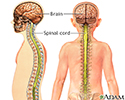Syringomyelia
Syrinx
Syringomyelia is a cyst-like collection of cereberospinal fluid (CSF) that forms in the spinal cord. Over time, it damages the spinal cord.
Causes
The fluid-filled cyst is called a syrinx. The spinal fluid buildup may be caused by:
- Birth defects (especially Chiari malformation, in which part of the brain pushes down onto the spinal cord at the base of the skull)
-
Spinal cord trauma
Spinal cord trauma
Spinal cord trauma is damage to the spinal cord. It may result from direct injury to the cord itself or indirectly from disease of the nearby bones,...
 ImageRead Article Now Book Mark Article
ImageRead Article Now Book Mark Article - Tumors of the spinal cord
The fluid-filled cyst usually begins in the neck area. It expands slowly, putting pressure on the spinal cord and slowly causing damage.
Symptoms
There may be no symptoms. If there are symptoms, they may include:
- Headache
-
Loss of muscle mass (
wasting
, atrophy), often in the arms and hands
Wasting
Muscle atrophy is the wasting or loss of muscle tissue.
 ImageRead Article Now Book Mark Article
ImageRead Article Now Book Mark Article - Spasms or tightness in the leg or hand and arm muscles
-
Muscle function loss
, loss of ability to use arms or legs
Muscle function loss
Muscle function loss is when a muscle does not work or move normally. The medical term for complete loss of muscle function is paralysis.
Read Article Now Book Mark Article -
Numbness
that decreases the feeling of pain or temperature; lowers the ability to feel when the skin is being touched; occurs in the neck, shoulders, upper arms, and trunk in a cape-like pattern; and slowly gets worse over time
Numbness
Numbness and tingling are abnormal sensations that can occur anywhere in your body, but they are often felt in your fingers, hands, feet, arms, or le...
 ImageRead Article Now Book Mark Article
ImageRead Article Now Book Mark Article - Pain down the arms, neck, or into the middle back or legs
- Weakness (decreased muscle strength) in the arms or legs
Exams and Tests
The health care provider will perform a physical exam and ask about the symptoms, focusing on the nervous system. Tests that may be done include:
-
MRI of the head
and spine
MRI of the head
A head MRI (magnetic resonance imaging) is an imaging test that uses powerful magnets and radio waves to create pictures of the brain and surrounding...
 ImageRead Article Now Book Mark Article
ImageRead Article Now Book Mark Article -
Spinal CT
scan with myelogram (may be done when an MRI isn't possible)
Spinal CT
A lumbosacral spine CT is a computed tomography scan of the lower spine and surrounding tissues.
 ImageRead Article Now Book Mark Article
ImageRead Article Now Book Mark Article
Treatment
The goals of treatment are to stop the spinal cord damage from getting worse and to improve function.
Surgery may be needed to relieve pressure in the spinal cord. Physical therapy may be needed to improve muscle function.
Ventriculoperitoneal shunting may be needed. This is a procedure in which a catheter (thin, flexible tube) is inserted to drain the fluid buildup.
Ventriculoperitoneal shunting
Ventriculoperitoneal shunting is surgery to treat excess cerebrospinal fluid (CSF) in the brain (hydrocephalus).

Outlook (Prognosis)
Without treatment, the disorder may get worse very slowly. Over time, it may cause severe disability.
Surgery usually stops the condition from getting worse. Nervous system function will improve in about half the people who have surgery.
Possible Complications
Without treatment, the condition may lead to:
- Loss of nervous system function
- Permanent disability
Possible complications of surgery include:
- Infection
- Other complications of surgery
When to Contact a Medical Professional
Call your provider if you have symptoms of syringomyelia.
Prevention
There is no known way to prevent this condition, other than avoiding injuries to the spinal cord. Getting treated right away slows the disorder from getting worse.
References
Batzdorf U. Syringomyelia. In: Shen FH, Samartzis D, Fessler RG, eds. Textbook of the Cervical Spine . Philadelphia, PA: Elsevier Saunders; 2015:chap 29.
Perron AD, Huff JS. Spinal cord disorders. In: Marx JA, Hockberger RS, Walls RM, et al, eds. Rosen's Emergency Medicine: Concepts and Clinical Practice . 8th ed. Philadelphia, PA: Elsevier Saunders; 2014:chap 106.
-
Central nervous system - illustration
The central nervous system is made up of the brain and spinal cord. The brain functions to receive nerve impulses from the spinal cord and cranial nerves. The spinal cord contains the nerves that carry messages between the brain and the body.
Central nervous system
illustration
-
Central nervous system - illustration
The central nervous system is made up of the brain and spinal cord. The brain functions to receive nerve impulses from the spinal cord and cranial nerves. The spinal cord contains the nerves that carry messages between the brain and the body.
Central nervous system
illustration
Review Date: 5/30/2016
Reviewed By: Amit M. Shelat, DO, FACP, Attending Neurologist and Assistant Professor of Clinical Neurology, SUNY Stony Brook, School of Medicine, Stony Brook, NY. Review provided by VeriMed Healthcare Network. Also reviewed by David Zieve, MD, MHA, Isla Ogilvie, PhD, and the A.D.A.M. Editorial team.

